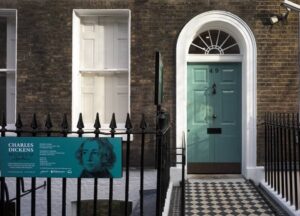5 Secrets Of Charles Dickens House In London
Date post added: 26th September 2024
Charles Dickens is one of the most famous writers not only in Britain but the world, creating novels such as Great Expectations, Nicholas Nickleby, Bleak House and David Copperfield. It was Dickens’ vivid portrayal of life in Victorian England through stories like Oliver Twist and A Christmas Carol that are said to have led to social reform.
But where did Dickens find inspiration for his stories? He observed life in the Victorian London streets and taverns that he visited throughout his life. Dickens lived in many houses across London during his life, but only two still stand today.
Where did Charles Dickens live in London?
Born in Portsmouth, Charles Dickens spent his early childhood in Chatham, Kent, and moved to Camden Town in London in 1822, aged 10. As a young man, he lived in Borough and Holborn. Once an established author, he moved on up to Marylebone.
Only two of the London homes of Charles Dickens remain. There’s a blue plaque at 48 Doughty Street (WC1N 2LX) in the London borough of Camden. Then there’s his former family home on Cleveland Street in Fitzrovia where he lived briefly as a child.
Can you visit Charles Dickens’ house in London?
Luckily for you, the answer is yes. Dickens home at 48 Doughty Street, London is now the Charles Dickens Museum. It’s here that he wrote some of his most famous works (read on to find out more).
The closest tube stations for the Charles Dickens Museum or London home of Charles Dickens are Russell Square and Chancery Lane, both a 10 minute walk and Kings Cross St Pancras is around 15 minutes away. Opening times are Wednesday – Sunday from 10am to 5pm.
If you’re planning a visit to Charles Dickens’ House (48-49 Doughty Street), don’t miss our 5 secrets to the Charles Dickens House in London listed below.
What was London like when Charles Dickens was alive?
Charles Dickens is a master of transporting the reader to another place and time. His descriptive writing and observations of the time paint a vivid picture of 19th century London. Victorian Britain was in the throes of the Industrial Revolution and the pros and cons that brought with it. Along with huge growth in global trade, there was untold squalor and poverty. Filth, stench, sickness – these were the daily experiences for many.
Picture smoking chimneys, bustling crowds, horse-drawn carts, sewage floating past and dimly lit streets. Add a dose of pickpockets, beggars, thieves, drunks and prostitutes, and you have a backdrop for wonderful stories.
Did Charles Dickens ever live in a workhouse?
The Dickens family did have a brush with poverty. In 1822, Charles moved with his sister and parents to Camden from Kent. His father had hit financial difficulty and ended up being imprisoned for a short while for non-payment. During that time, 12 year old Charles had to work in a boot-blacking factory and live in lodgings. The experience scarred him greatly.
When he lived in Cleveland Street, he would have been very aware of the workhouse a few doors down the street. His eye witness accounts were reflected in his works, Oliver Twist in particular.
1. Where Dickens created many of his greatest works
“Please Sir, I want some more,” said the orphan Oliver to the cook at the workhouse in Oliver Twist, a novel that revealed the bleak conditions for children in Dickensian Britain. It was behind the Georgian façade of 48 Doughty Street, a terraced house in Holborn, central London, that Dickens sat at his writing desk to pen not only Oliver Twist but The Pickwick Papers, Nicholas Nickleby and the beginning of Barnaby Rudge too. One of the first rooms any Dickens fan will seek out when entering the last surviving home of Charles Dickens is surely his study.
The Dickens Fellowship purchased the Dickens House in 1923, and today the museum is set up as it would have been in Dickens’ day. Even down to the writing desk where he will have created those famous original manuscripts. Listening to Mary Dickens’s recollection of observing her father at work in his study, available at dickensmusueum.com, is fascinating.
2. The inspiration for A Christmas Carol
Charles Dickens leased a number of homes in London, including Devonshire Terrace and Tavistock House in Bloomsbury, and only ever purchased one- Gad’s Hill Place in Rochester, Kent. But it was to 48 Doughty Street that Dickens moved with his wife Catherine and her younger sister Mary. It is that London address that remains connected to the Dickens family.
Mary passed away in 1837, the same year that Charles and Catherine Dickens moved to the house. The loss of his sister in law is said to have deeply affected Dickens and may have influenced the novella A Christmas Carol, where three spirits visit Ebenezer Scrooge. In the Dickens House Museum audio guide, you can hear an excerpt of a letter Dickens wrote to his mother in law: “After she died I dreamed of her every night for many months. I think for the better part of a year. Sometimes as a spirit, sometimes as a living creature. Never with the bitterness of my real sorrow but always with a kind of quiet happiness which became so pleasant to me that I never lay down at night without a hope of the vision coming back in one shape or another.” A portrait of Mary Hogarth can also be seen in the room dedicated to her at the Dickens House Museum.
3. Dickens the entertainer
The Charles Dickens Museum is set out across 5 floors. From the basement kitchen and washhouse to the top floor servant’s bedroom, there are over 100,000 personal items relating to Dickens housed here. On the ground floor you will find the dining room, surely the scene of many sociable gatherings. A letter from Dickens to his friend John Harley to invite him to dinner gives us an insight into Dickens’ delight in having his friends about him: “I took it into my head yesterday to get up an impromptu dinner on this auspicious occasion… I know you can’t dine here in consequence of the tempestuous weather on the Covent Garden shores but if you will come in when you have done Trinculizing you will delight me greatly, and add in no inconsiderable degree to the conviviality of the meeting.”
4. Slasher Mary lived here too
A little known secret about The Dickens Museum is that it also had another famous inhabitant. Canadian suffragette Mary Richardson, known as Slasher Mary for her attack on Rokeby’s painting Venus in protest at the arrest of Emmeline Pankhurst, lived at 48 Doughty Street following her release from Holloway Prison. At the time, Dickens’ House was a hostel for single women. We can imagine Mary going to bed the night before, in one of the bedrooms on the upper floors, knowing what she was going to do the next day. Then, getting up in the morning, hiding the meat cleaver about her person and leaving 48 Doughty Street for the City of Westminster and the National Gallery.
5. Not just the writer, but the showman too
Whilst some British authors only attained fame after their death, Charles Dickens experienced great success during his lifetime. As well as being a talented journalist and novelist, Dickens was an amateur actor and performer and greatly enjoyed sharing specially constructed editions of his novels in public. So much so that Dickens designed the reading desk which is on display in the Drawing Room of the Charles Dickens Museum. With a raised platform where Dickens could lean his arm to hold his book, and different levels to hold his water, and a letter opener used to convey dramatic gestures, this little piece of history shares an insight into another side of Dickens’ character- not just the writer but the showman too.
Of course, Charles Dickens House is just one of the many London scenes that we associate with the literary great. To see more of Dickens’ London, book a tour with London Walks.



